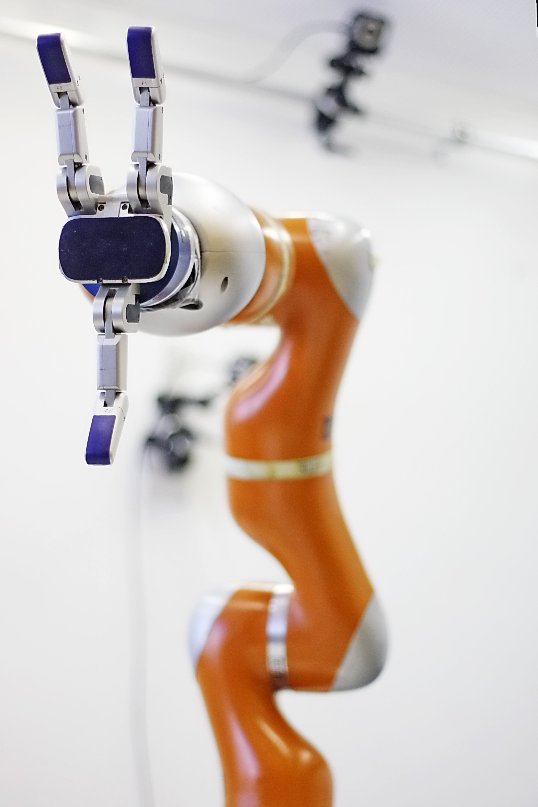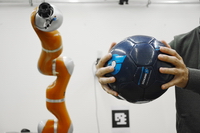| Implementation of the singularity free inverse kinematic solution for redundant robots Ben Hattar Benjamin Henri (PH) Redundant manipulators have been designed to improve manipulability, flexibility and dexterity. One of the most fundamental issues regarding redundant manipulators is solving the inverse kinematics problem; i.e. finding a feasible joint trajectory given the end-effector’s trajectory. Solutions to the inverse kinematics problem can be formulated to handle joint physical limits, singularities, obstacle avoidance and to optimize various performance criteria, while conducting the primary end-effector motion task. The aim of this project is to implement a singularity-free inverse kinematics solution for a 7 Degree of Freedom –DoF– KUKA LWR, subject to equality and inequality/bound constraints such as joint limits, angular velocity and acceleration limits. The student will first implement this in C/C++ in a simulator in linux environment and then with the real robot, a 7 DOF arm from KUKA. Project: Semester Project Period: 15.06.2015 – 15.12.2015 Section(s): EL IN ME MT Type: 20% theory, 50% software, 30% experiments, Knowledge(s): C++, Linux Subject(s): Robotics, Inverse Dynamic, Dynamical system Responsible(s): Seyed Sina Mirrazavi Salehian, Nadia Figueroa |  |
| Controlling a redundant robot for the task space manipulations Guillaume Clivaz (MT) Redundant manipulators have been designed to improve manipulability, flexibility and dexterity. One of the most fundamental issues regarding redundant manipulators is task space manipulation; i.e. finding a joint level command corresponding to the desired end-effector’s trajectory. There are two general solutions to solve this problem. The first option involves, directly solving the inverse kinematics problem by finding a feasible joint trajectory given the end-effector’s trajectory. An alternative option is to use a task space inverse dynamic controller. The aim of this project is to control a redundant robot in the task space, subject to equality and inequality/bound constraints such as joint limits, angular velocity and acceleration limits. The student will first review literature on related topics, then the proposed control architecture will be implemented in C/C++ in a simulator in Linux environment and then with the real robot, a 7 DOF arm from KUKA. Project: Master Project at EPFL Period: 19.02.2015 – 19.08.2015 Section(s): EL IN ME MT Type: Theory(40%), Robot Implementation (30%), Programming (30%) Knowledge(s): C++, Linux, Matlab Subject(s): Robotics, Inverse Dynamic, Task space manipulation, Dynamical system Responsible(s): Seyed Sina Mirrazavi Salehian, Nadia Figueroa |  |
| Studying the arms motions in the catching a flying object scenario Alberto Arrighi (MT) Dynamic motions such as catching, hitting and throwing require accurate trajectory and motor control generation. Humans can instantly execute these motions with excellent accuracy and speed. For example, the problem of catching an object requires ?getting the hands to the right place at the right time?. To successfully catch an object, humans move their hands in coordination to intercept and stop the object. The aim of this project is to study the motion of human hands when catching a large object with both hands. This project consists of two main phases. In the first phase, the student should record the kinematic of hand motion and build a data set of typical postures of arms, hands and fingers and the object. The motions are recorded by using the Optitrack motion capture system, available in the lab. In the second phase, the data are analyzed to find potential correlations between the relative postures of the arms & hands and the position of the object in the person’s workspace. Project: Semester Project Period: 01.06.2015 – 01.12.2015 Section(s): EL IN ME MT Type: 20% theory, 10% software, 70% experiments, Knowledge(s): MATLAB, C++, machine learning background Subject(s): Motion study, Machine learning Responsible(s): Seyed Sina Mirrazavi Salehian, Edouard Lagrue |  |